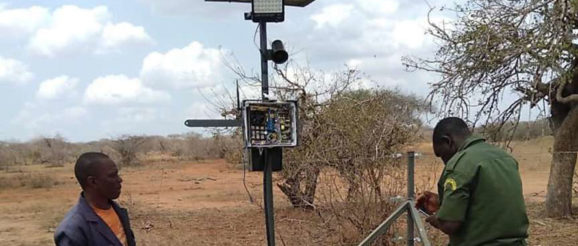How teens’ innovation keeps elephants at bay – Business Daily

Technology
How teens’ innovation keeps elephants at bay
Friday, March 6, 2020 22:44

There are many ways to keep elephants from destroying crops or attacking people.
Erecting electric fences around national parks and game reserves is one. But how much would it cost to fence the expansive Tsavo National Park?
The use of bees and pepper has also been tried and tested. And in some areas, villagers bang drums to turn away the animals, which are averse to noise. But how many beehives would have to be placed around the Tsavo to keep farms and farmers safe?
Luckily, there is a new innovation that could prove as effective. Known as Animal Sandra (Anisan), the technology was invented at Kajire Girls in Voi, Taita Taveta County, in 2018 by four students as part of a competition.
Sandra Maryanne, Joyce Matoto, Nancy Wairimu and Macrina Antonia were motivated to come up with the idea because they had experienced human-wildlife conflict in their home area, which borders the Tsavo.
Learning was frequently interrupted and many were the days students reported to school late and left early to avoid encountering elephants along the way.
Their parents grow crops on the fringes of the park, which attracted the animals.
In many instances, farmers have had to kill elephants to save their crops but, once in a while, a hapless villager falls victim to an attack.
So how were such conflicts to be resolved?
The quest for an answer led the four friends to think of an idea that could reduce human-wildlife conflict.
“We want both humans and wildlife to co-exist and this will lead to a peaceful community and good performance in school,” Sandra said in an interview with The Edge.
In its nascent stage, the four students named their innovation the “Ndovu Care Project”. Their hope was that the innovation would help keep elephants away from crop fields and community areas and, in the end, provide a permanent solution to perennial conflict between man and beast.
Guided by their teacher Ezra Abuga, they submitted their innovation for the Start-Up Africa Diamond Challenge competition for the most innovative technological invention.
The competition was held in Elgeyo-Marakwet County and the girls won the first prize. As a result, they qualified for a global challenge to represent Kenya at the University of Delaware in the US after defeating 85 other projects presented by secondary schools from across the country.

When Sandra, now 18, completed her secondary education in 2019, she continued making improvements on the portable device, which consists of a GSM card, a motion detector, a warning light and a siren.
The gadget can detect an elephant at a radius of 180 metres, after which it sends alerts to the Kenya Wildlife Service (KWS) as well as villagers, preparing them to act before the animals start destroying crops or making their way to habited areas.
The warning text messages are sent to individuals whose phones are linked to the GSM card.
“The sensors are capable of detecting the presence of an elephant and immediately alert people by setting off flash lights and a siren, besides sending warning messages to KWS and villagers’ phones,” said Sandra, after whom Anisan is named.
The gadget, which is solar-powered, is hoisted on masts at strategic points where the sensors can detect the movement of elephants.
The device has been subjected to numerous experiments by different organisations and institutions to test whether it can work efficiently.
“Recently it was mounted at Rukinga Ranch so we are waiting for the results of that experiment,” said Sandra.
“This device will minimise poaching and deaths of elephants and residents respectively. The economy and nutrition of communities will also improve because crop destruction will be a thing of the past,” she said.
This is one of the innovations featured in The Edge, a quarterly magazine published in Business Daily on Friday, March 6. Get your copy for more: epaper.nationmedia.com
